
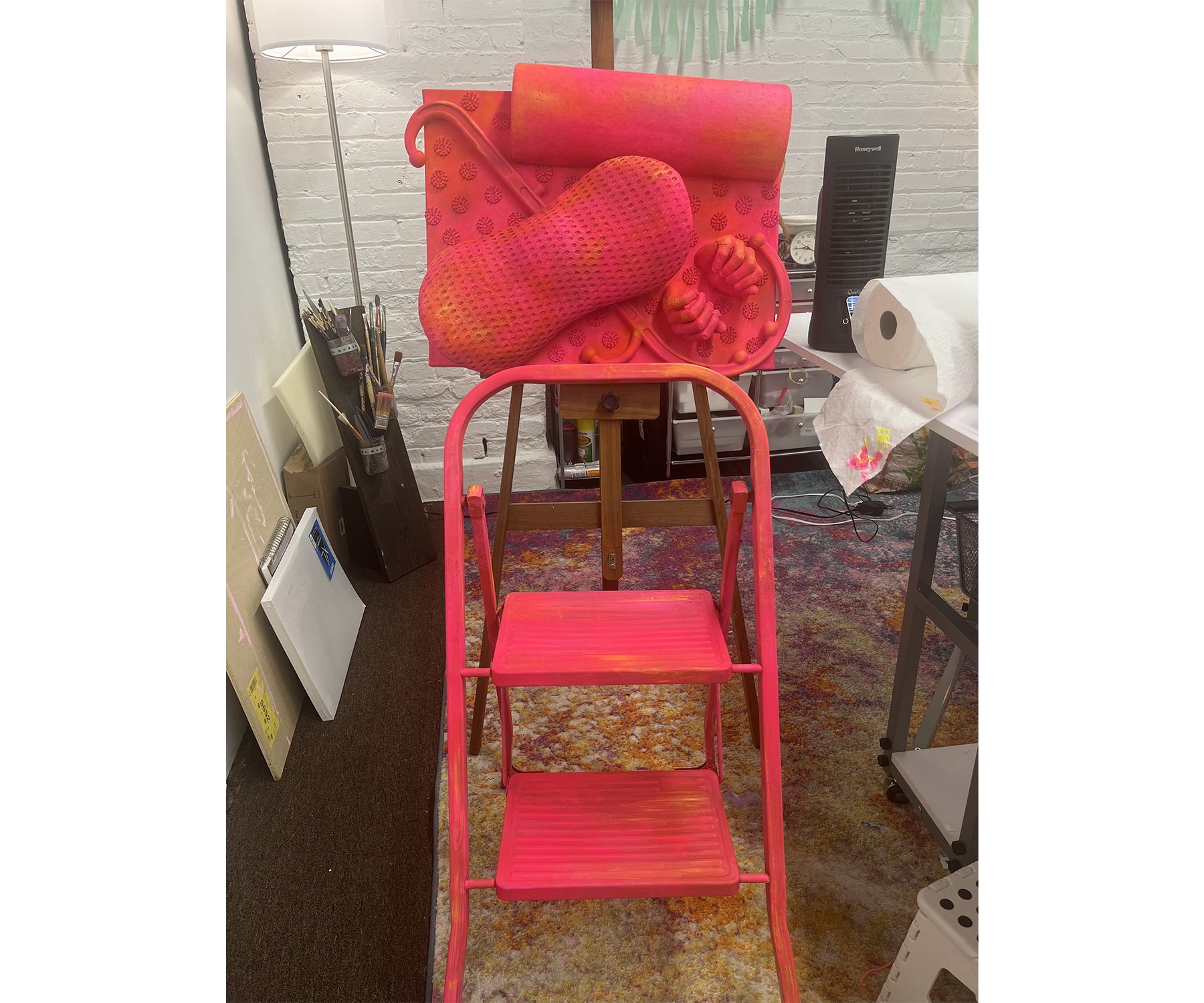
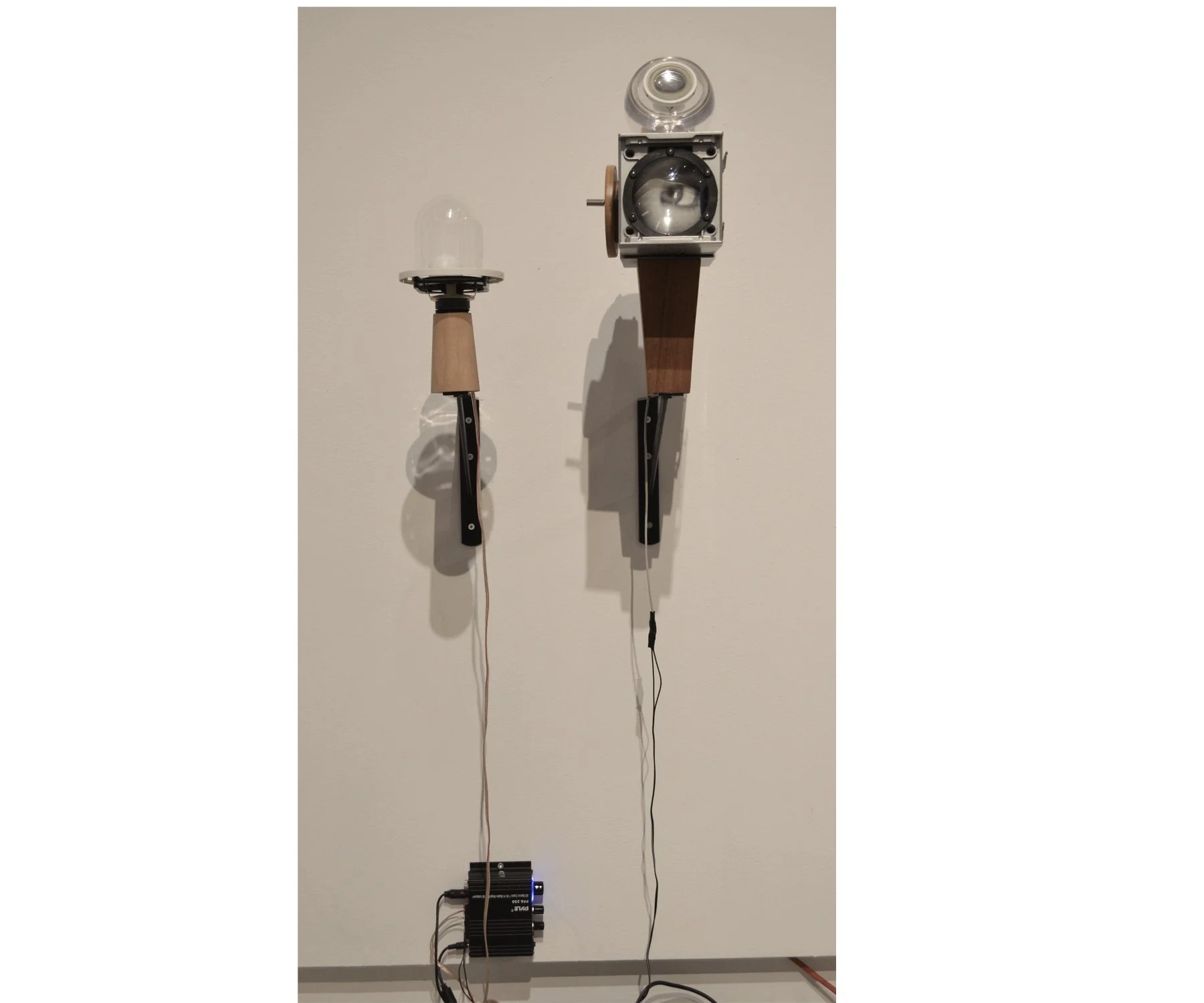
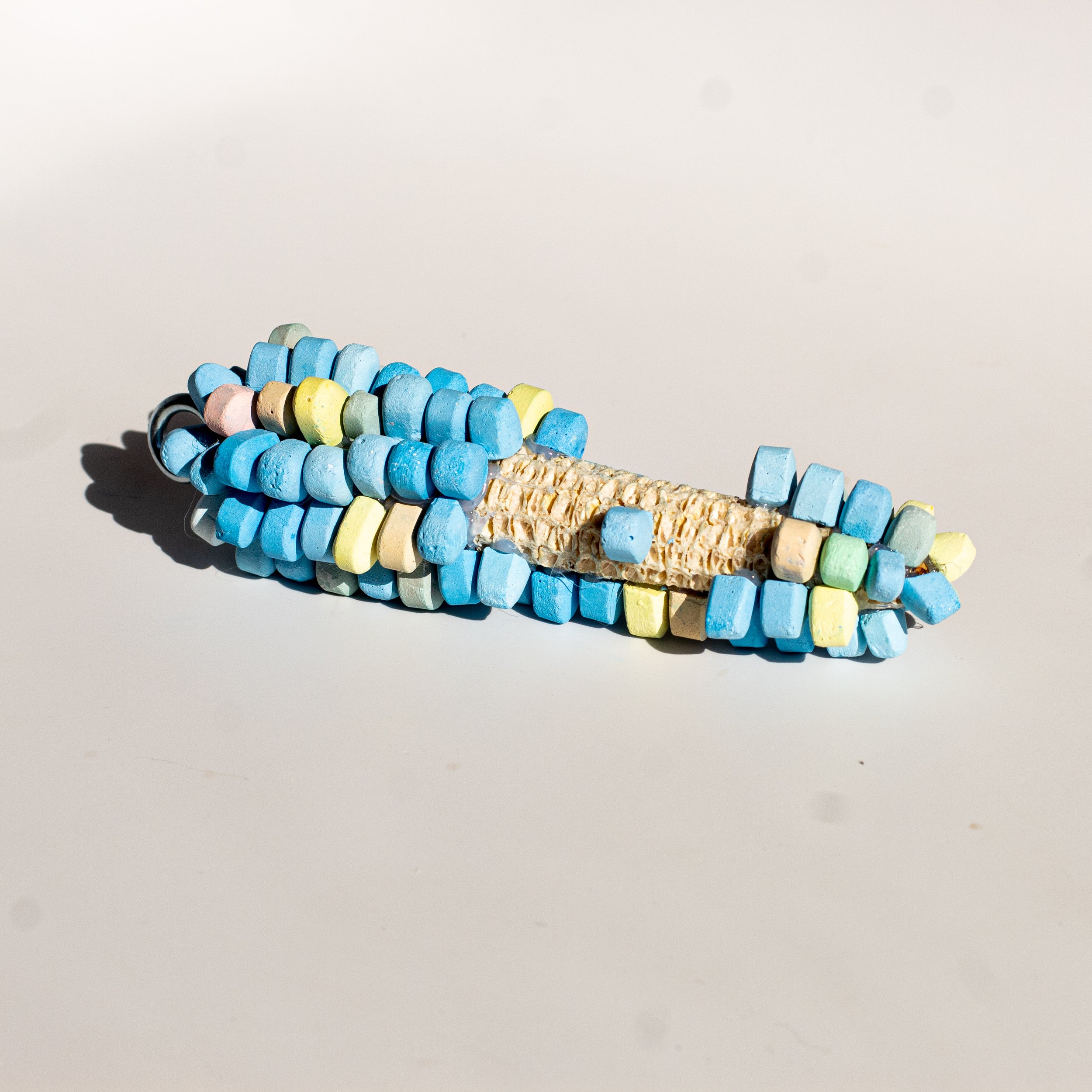








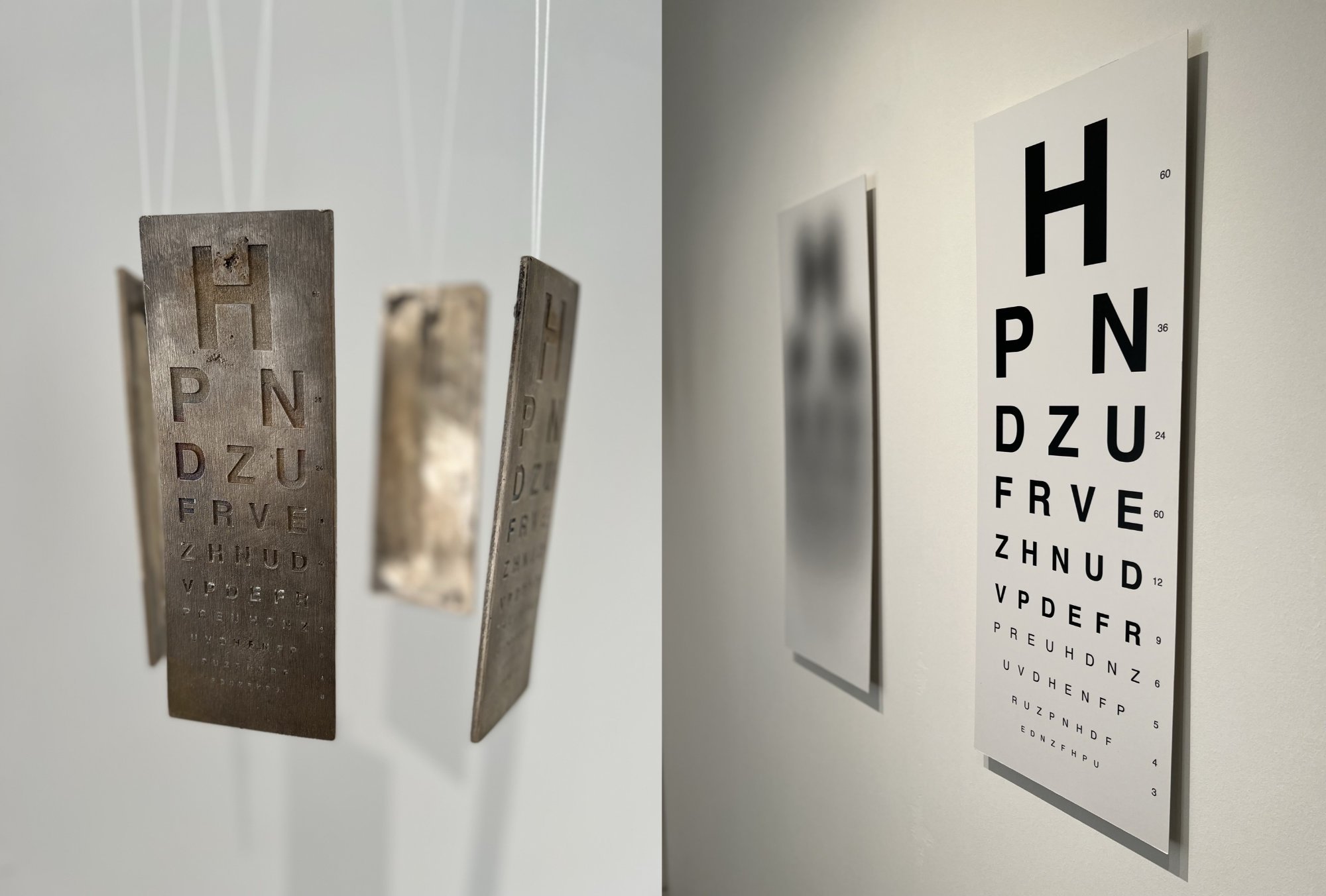
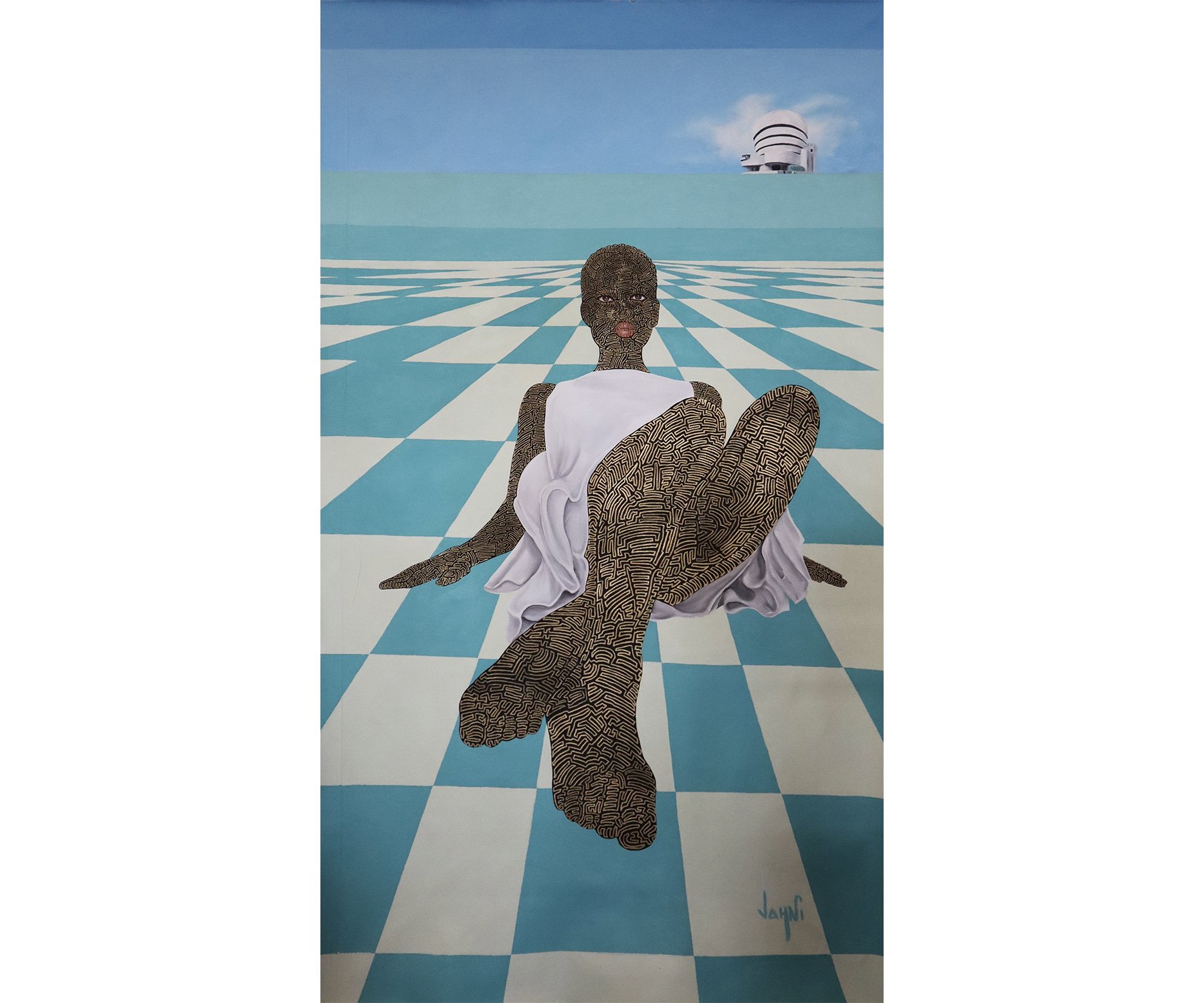



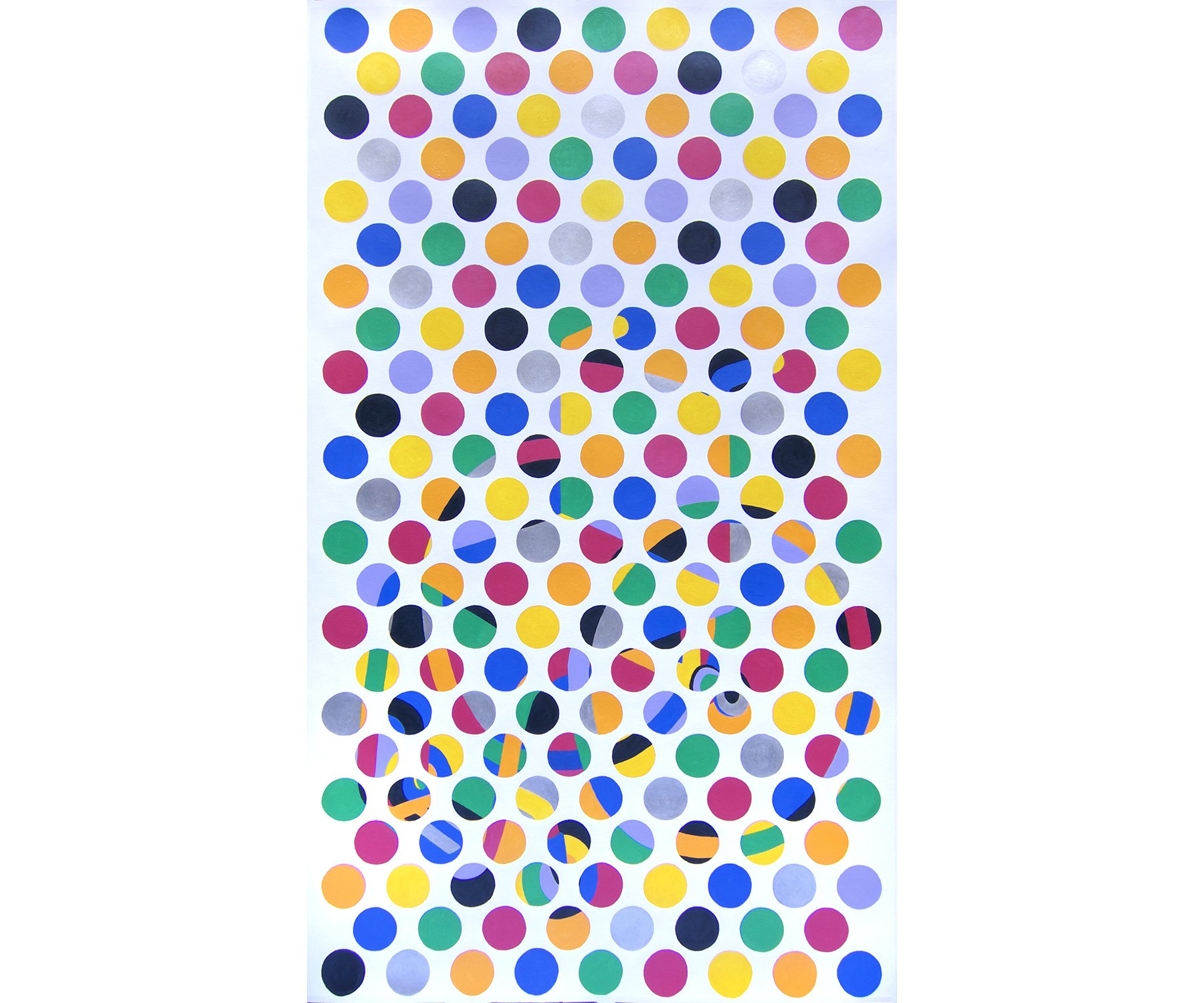
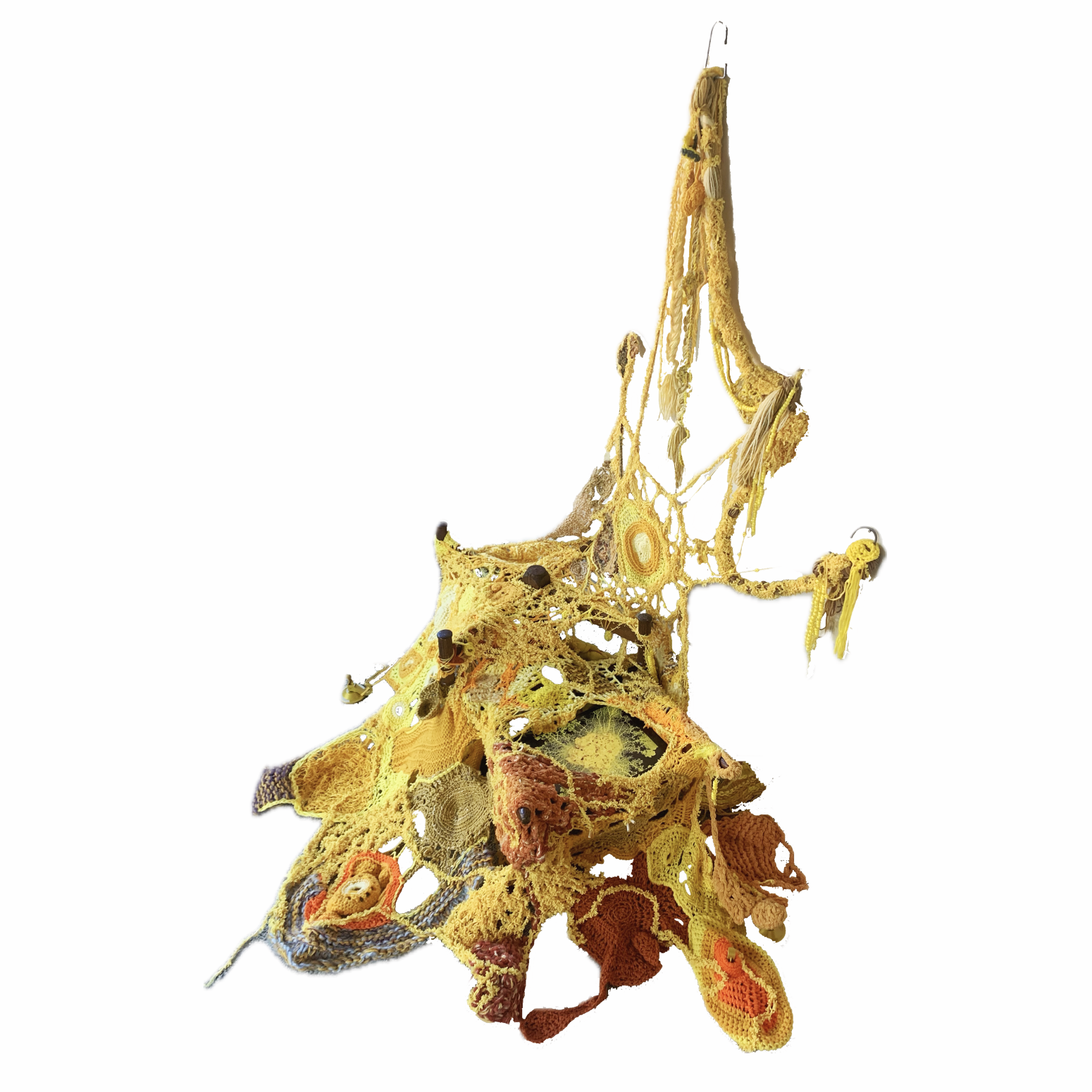
Your Custom Text Here
“In Tandem”
2024
Mixed Media
Bri Beck (she/her) is a mixed media artist and art therapist. As a person with a rare form of dwarfism, Bri’s art often speaks to the relationship between her body and the built environment. Further, her work speaks to how this relationship can create moments of connection or distress depending on the level of tension. In her piece, “In Tandem,” Bri considers how designed objects that are intended to assist in her access can also cause discomfort and more chronic physical issues. As someone who often utilizes a step ladder, particularly in the domestic environment, Bri must often over-exert her body to accomplish “basic” tasks in the home such as cooking a meal on the stove. Consistently navigating a built environment that’s not ergonomically sound for her body, Bri must also utilize other designed objects, including the hands of her husband and physical therapists, to manage muscle inflammation and strain in her joints. “In Tandem” is a messy love letter to designed objects. It represents the way that even essential objects can cause us a type of experience, in this case pain, that then leads us to the need for objects that restore us back to some semblance of equilibrium.
"Private Eye"
2021-2023
recycled objects, vintage Apple computer speaker, photograph, speaker, ping pong ball, glass, metal brackets, mini amp, audio components, audio file
David Bobier is a hard of hearing and disabled media artist whose creative practice is researching and developing vibrotactile technology as a creative medium and language of expression. This ongoing work led to his establishment of VibraFusionLab originally in London, Ontario, a creative multi-media, multi-sensory centre that has gained a reputation as a leader in accessibility for the Deaf and disability arts movement in Canada and internationally. The Lab has recently been re-established in Hamilton, Ontario. As a practicing artist his exhibition career includes 18 solo and over 30 group exhibition projects across Canada and in the United States, France, Costa Rica and the UK.
Bobier has served in advisory roles in developing Deaf and disability arts Equity programs for both Canada Council for the Arts and the Ontario Arts Council and was an invited participant in the Canada Council for the Arts – The Arts in a Digital World Summit and a panel presenter at the Global Disability Summit in London, UK. Bobier twice received Canada Council for the Arts funding to do ongoing research of the Deaf and disability arts movement in the United Kingdom and the United States.
‘Private Eye’ dismantles colonial traditions of filmmaking and photography by underscoring the experience of sound as vibration and as having a visual context. Instead of looking into a viewfinder we are confronted with an enlarged image of an eye peering out at the viewer. An audio of underwater recordings emanates from a vintage Apple computer speaker causing its surface to vibrate. The same audio is passed into a speaker under a glass dome activating a ping pong ball in response to the audio frequency thus offering the viewer an added medium and sensory perception of sound. By incorporating the underwater recording it offers the viewer a multi-sensory transformative experience unavailable to many from the Deaf and disabled Communities.
“Elotes Antirretroviral / Antirretroviral Corn”
2024
Mixed media. Ceramic casing of hiv treatment, natural pigment, wood, silicone and steel
An elotiza a celebration that takes place in the cornfield on a harvest day. During the paty, corn is eaten roasted or boiled with its leaves. These events have great meaning for me as a farmer, queer artist and person living with HIV. An elotiza involves a wrinkle in time, where the profits of labor are counted while preserving the grains that will be planted the next season. The notion of future that accompanies the ingestion of corn is similar to the clinical conviction of extending life by taking antiretroviral treatment. In Tlaxcala, the city where I was born, live and work, the cultural importance of corn and native grains is unquantifiable, the name of the city alone means “corn tortilla place” in nahuatl language. Similar to the cultural importance of HIV in the queer community: Indivisible fights. How to establish a poetic relationship between these two fields? Who is allowed to produce new images of HIV? When does hope happen? These questions led me to turn pills into seeds, experiment with different ways of nullifying the clinical function of the treatment and turning it into a metaphor for myself.
“Corpus: Medical Debt Stage”
2024
mixed media
Gabriel Chalfin-Piney is a Chicago based object maker and organizer. Abolitionist world building, self taught spiritual and artistic practices, and accessible performance enters much of the work they create. They are interested in making by way of olfactory, gustatory, and tactile experiments, prompting audience members to participate as co-creators.
Defined by the welcoming color story taken from disposable dental bibs, Chalfin-Piney’s modular sculpture-set invites from afar with its cooling colors yet produces a painful wince at closer inspection. A densely populated altar offers intimate moments from the artist’s hand and mouth. The work shows the medical world slowly taking over nature through color, with elements of hope shining through. The rock's collected by Chalfin-Piney are part of the artist's personal collection of found gua sha tools, which morphed into stim toys overtimes—lake and ocean gifted, untouched by western medicine. The sculpture acts as a set and first act for a forthcoming performance, revealing two stories—one of dental trauma and the disabling chronic pain created during a series of medical malpractice surgeries— one of physical relief and healing outside of the medical industrial complex: a path that might offer a modicum of relief from a body attacking itself. The performance, created with Chicagoans who have experienced dental trauma and chronic pain, activates research and healing engaged through bodyworking modalities in naprapathy, thai massage, cupping therapy, gyrotonics, moxibustion, gua sha and acupuncture.
“Can you hear me?”
The collection of “Charlie Chimps” and spondee (two syllabi words) vocabularies are tools used in audiology in the 80s and 90s to determine if a child is deaf and how deaf they were. The monkey was the artifact that determined the artist’s identity as a deaf child by not looking at it when it was making a clashing sound with cymbals. It is a common object found in audiologist booths across America. The haunting stare and the aggressive motion of the monkey were some of the artist’s earliest memories, as he was tested for his ability to hear. How can one comical object define the artist’s future as a deaf person? The artist revisited “Charlie Chimp” after three decades of not experiencing the object again to deconstruct, repurpose, and redefine what “Charlie Chimp” can be into a visual delight for the viewers.
About Justin Dougan-LeBlanc
Justin Dougan-LeBlanc of Justin LeBlanc Design is a Deaf and Queer installation artist and textile designer. He is an Associate Professor of Fashion Studies at Columbia College Chicago where he teaches fashion and installation design. LeBlanc’s interdisciplinary career spans fashion, textile art, architecture, and technology. LeBlanc aims to push art and education forward by combining the strengths of emerging technology like 3D printing with the traditions of the hand. This knowledge and experience in multiple disciplines and his upbringings as a Deaf person allows him to exploit and fuse different approaches, resulting in artistic expression that cannot be conveyed by one discipline alone. All his works explores the topics and storytelling on Deaf Culture and LGTBQIA+. LeBlanc has been featured in a number of publications, exhibitions, fashion shows, and television in the United States and internationally. These include Mercedes New York Fashion Week, Marie Claire, Red Eye, The Chicago Tribune, the New York Times, USA Today, and The Face Magazine. He has competed on Project Runway and Project Runway All Stars. LeBlanc’s undergraduate degree is in Architecture from North Carolina State University, and his master’s degree is in Fashion Design and Installation from School of the Art Institute of Chicago.
People talk about core memories—memories that have impacted the trajectory of their personal journey. The artist, Justin Dougan-LeBlanc was born deaf. He is Deaf. His core memories are seen and defined through the lens of a deaf person. The collection of works on display explores the dialogue of the queer deaf experience through sculptural artifacts that capture his personal moments, feelings, and thoughts. Each work explores how people perceived the artist as a broken, crippled, or a lesser human. Society’s viewpoints only give the artist the opportunity to challenge, teach, and overcome with his unique stories that he will share.
Contact: JustinLeBlancDesign@Gmail.com
“WHEN I STOP LOOKING”
2013 - Video - 15 minutes
Going beyond the imprint of appearances, When I Stop Looking invokes the intensely private worlds of those portrayed, each of whom lives with significant facial and cranial conditions; a vivid affirmation of existence comes forward, before anything else.
Todd Edward Herman is a visual artist and curator. He is the founding director of East Window Gallery and co- founder of Sins Invalid Performance Project. Todd has been the recipient of many awards for his work including, the San Francisco International Film Festival, The Art Council of Northern Ireland, San Francisco Film Arts Foundation, Western States Regional Media Arts Fellowship, The Arts Commission, Community Foundation and Arts Alliance of Boulder County, and the Emerging Curator Award from The San Francisco Art Commission.
Todd has presented his films and photographs at such venues as The International Film Festival Rotterdam, San Francisco International Film Festival, Southbank Centre, Design Museum of Chicago, New Benaki Museum, Kharkiv Holocaust Museum, Melbourne Museum of Art, Anthology Film Archives, San Francisco Cinematheque, Pacific Film Archives, RedLine Contemporary Art Center, The Dairy Arts Center, Arvada Center for Arts & Humanities, Vicki Myhren Gallery and Leon Gallery. Todd currently lives in Boulder Colorado with his family.
“My work questions habits of understanding, looking, and storytelling; investigating how personal and historical forms are constructed rather than fixed. This means finding new ways to generate work that examines how images compose, enforce, or undermine—rather than simply reflect—ideas of history, dominant values, authenticity and authorship.”
Are You Seriously Serious? (quilt)
2023
puffed screen prints on mixed fabrics, glass beads, sequins, and batting Size: 44”x54”
I am stuffed with poly-fil– held together with sloppy stitches. Often, slanted, bold text runs over me shouting at viewers in a soft material that cushions any blows. At first, I am funny and fast and then something else underneath lingers. Maybe there is more to this quick wit afterall.
---
Libby Evan is a disabled artist, researcher, and activist. Originally from Albany, NY, she now resides in Chicago, IL. She is currently a PhD candidate in Disability Studies at the University of Illinois, Chicago. In 2024, she earned her MFA in Fiber and Material Studies at the School of the Art Institute of Chicago. She holds a BFA in Studio Art from Washington University in St. Louis, The Sam Fox School of Design and Visual Arts. Evan’s art practice and research focuses on her experiences of having invisible disabilities as she breaks down the façade of being okay on the outside but not so much on the inside.
"My Big Chin"
2020
Oil and pencil on vellum
My Big Chin is part of an ongoing series of portraits titled “To Plumb Rough Matter” which are created through a process of storytelling, photographic sessions, and painting. To make the portraits, I work with my subjects to reflect on their relationship to their body and intersecting identities. Through conversations guided by questions about their personal history and unique sense of self (physically, spiritually, and psychologically), each person identifies areas of their body that they routinely observe, touch, and think about. I then take a series of photographs focusing on the chosen parts of their bodies. These images serve as my primary reference in making the paintings with additional in person sessions as needed. Many of my subjects, myself included, have shared experiences of living with various disabilities. In My Big Chin, my own disabilities are reflected in the painting in subtle ways (skin discoloration, hair, scar tissue) that perhaps only someone with shared experiences would pick up on. The subtlety and specificity of the painting reminds us that disability is not always immediately perceived by those outside of ourselves but is incredibly common. My portraits, like My Big Chin, are a celebration of the multiplicity and ambiguity of disabled embodiment.
Julia González (she/they) is a queer, disabled, Mexican artist based in Chicago. Their work fluctuates between the hyperreal and the abstract, resulting in material and psychological tensions. González depicts minute particularities and subtle movements to invite slow and careful observation. Her practice is social, she strives to arrive at a place of mutual understanding through dialog and intimate study. González’s close relationships with their subjects fosters a compassionate mode of image-making that seeks to illuminate the complex ways we exist in relation to one another.
“Coexistence”
2023
Digital Art Print.
Dilara Koselioren was born in 1997 in Istanbul, Turkey. After completing her studies, she came to London (UK) to study at the University of Arts London, where she studied Interior Design. During her study, she started expressing her art with graphic and digital design. After completing her BA in Interior Design in 2021, she started focusing on her art career as an artist. She attended different art exhibitions and publications, such as Always Together (The Holy Art Gallery London), Utopia Group Exhibition (The Holy Art Gallery Athens), CICA New Media Art Conference (NMAC) 2023 as a ‘Solo Exhibitor’, London Design Festival 2023, London Design Fair 2023.
She is reflecting on human emotion and focusing on how daily interactions and different socio-economic and cultural differences, and the areas that we live in affect our daily lives. She is asking questions and making viewers of her work think. She reflects on how any part of society can relate to emotions and find something.
That’s how she is improving her art.
"Embroidered-Touch Tablecloths"
(2022)
Cloth, electronics, conductive wire, recycled wood, video (installation view Facility, Chicago)
Designer, artist, and educator Anke Loh works at the intersection of fashion, art and technology. With a focus on textile development and wearable tech, she collaborates with scientists, designers, artists and community members to explore ways to build community through craft and making. The array of textiles and garments she has created, many from recycled materials, features varying degrees of touch sensitivity that elicits sounds as a response to touch. Her tablecloths with interactive embroidery displayed on custom tables made with repurposed legs and tops, are the result of her collaboration with the Niederrhein University of Applied Sciences in Germany, and Chicago artists Christine Shallenberg and Peter Maunu. When touched, the sensory embroidery “plays” soothing soundscapes assembled from field recordings of nature and urban spaces, along with a blend of spoken words, string and percussion instruments. Loh’s long-term research objective is to discover new ways for technology to alleviate feelings of isolation, particularly among marginalized communities, an approach influenced by the pandemic and social unrest in the US. It also is a response to the need for change in the fashion industry to foster sustainable practices for creating, producing and consuming garments.
Loh’s multi-disciplinary approach has attracted international recognition and awards, including the Laureate at the Festival International des Arts et de la Môde in Hyères, France. Her work has been featured at New York’s Fashion Week, the Centre Pompidou in Paris, Japan’s Osaka Collection Show, and Mode Expo Antwerp, Belgium.
“Homing Body”
2023
Paper, clay, lightbulb, polymer, thistle
Miles Matis-Uzzo (b. 1996, Long Island, NY) is a Texas-based artist and superorganism who communicates through sculpture, poetry, video, perfume, performance, and installation. Their process includes material, chemical, and mythopoetic interventions that respond to how the queer body is impacted, manipulated, altered, and deteriorated. Matis-Uzzo has presented work at ICA/Boston, The Anderson, Larrie NYC, Spore Space, and Distillery Gallery, among others. They have participated in residencies at Ox-Bow School of Art & Artist Residency, NARS Foundation, and Otis College of Art and Design. They are currently a MFA candidate in Sculpture and Extended Media at The University of Texas at Austin.
“Subjective Acuity”
2022
Bell-bronze castings.
Subjective Acuity is an installation of four interactive bell-bronze sound sculptures drawing on the theme of the Snellen Chart and the measurement of visual acuity. The Snellen chart is an eye test chart developed in the 1860’s by Dutch Ophthalmologist Herman Snellen. Versions of this are still in common use today.
The small bronze castings [20 x 7 cm] of the same chart are hanging on lines. These objects have slightly different sounds and can be touched and collided to make chiming sounds. Beholding the work involves a number of senses, vision, touch, sound and smell. When handled, the bronze reacts with the oils of the hands and leaves a scent, reminiscent of that when handling copper coins. This work intends to question beholders about how artworks might be engaged with as well as the nature of measuring visual acuity. The lived experience of the artist has been included both literally, with the chart which he cannot see, as well as metaphorically, with the idea of sound, touch and smell being important elements in beholding.
“Destiny’s World: Beyond the MotherBoard”
2022
acrylic and red clay on canvas
In my practice, I draw the line, highlighting the path in the golden route that defines us from an endless space. This single traveling line represents a coded map from an immutable past to a self-determined future—a technique I call goldmapping. Each person walking this planet has a blueprint —a goldprint—individual units of theurgical energy that fit into the larger context of our connections. We each determine where we stand in the space we share, positioning ourselves on the cosmic continuum. I honor the Lifeblood/Earth/Clay connection by infusing red clay into my work as a charging agent.
This acrylic and red clay painting is a play on the word destiny and our contemporary operations regarding the digital and virtual experience as existence. It gives a nod to Andrew Wyeth’s iconic painting, Christina’s World, in which a young woman with a birth defect that leaves her unable to walk, lies in a field with a house in the distance. The piece relays a sense of beauty and hopelessness against the landscape. In Wyeth’s painting, we witness a lack of access in terms of mobility for Christina to get to the house/home without the aid of someone else. In my work, I dance with the idea of ready access, my destiny, by way of digital proxy, to enter the larger art world (represented in the painting as the Solomon R. Guggenheim Museum) as a southern based artist. The digital age has constructed a new landscape, a more accessible framework. It opens alternative connections of agency. Destiny’s World presents a different perspective, a contrasting gaze to the viewer toward an outcome beyond the original barriers and intent of institutions to serve as gatekeepers to the creative excellence of others.
“chalk underneath objects”
2021-ongoing
found objects, chalk
The series chalk underneath objects (2021-ongoing) is a collection of unwanted and “broken” furniture found in alleyways and thrift shops. These objects, reminiscent of unprimed canvases, also share the feature of semi- permeable surfaces. When chalk is applied, ground across the perforated planes, the fine powder falls through and settles on the ground where it remains as a shadow of the object. It reveals a quality that is beyond its previous function yet no less valuable. Each piece in the collection is imperfect, like the missing wheel on the rolling rack that tilts, the recognizable performance of the object shifted, a shape of its misperformance cast as a shadow and temporarily recorded in chalk. The functionality of the “broken” object may appear reduced at first glance, but on closer inspection is enhanced in others.
Jonas Müller-Ahlheim (*1993 in Wiesbaden, Germany) is a German artist, curator, and educator, who works across multiple media including sculpture, painting, installation, performative acts, and video. He studied Media Art at the Royal Academy of Fine Arts, Copenhagen and graduated in 2021 from The Art Academy Karlsruhe as a Meisterschüler with Professor Leni Hoffmann. From 2021 to 2023 he was awarded the DAAD - fellowship to continue his research at the Painting Department of the School of The Art Institute of Chicago (SAIC), from which he graduated with an MFA. In 2023 he was awarded a teaching fellowship at the School of the Art Institute of Chicago.
“Untitled (disquiet)”
2023
Pigmented resin, wood
S. Proski is a blind/disabled artist, writer, educator, and advocate. Their work addresses their own personal
experience of blindness, while questioning the imposing hierarchical structures that continue to shape, oppress,
and favor the ocularcentric.
Amigas
After finishing this piece, I couldn’t help but marry its completed expression to Mia Mingus’s blog post, “Wherever You Are Is Where I Want To Be: Crip Solidarity.” Its sentiment narrates that we will always find ways to stay together and support each other, creating our own paths and practicing love and interdependence in the face of ableism and isolation.
I began this piece by referencing a photo taken by a photographer I collaborated with in my Crip Paint Power portrait series. This contemporary, expressive figure painting features Reveca Torres and myself, Genevieve Ramos, presenting a vibrant visual juxtaposition on the faded lines of a vintage architectural blueprint. The vintage blueprint symbolizes the foundational plans of society—its structures, policies, and systems. Traditionally, these plans are conceived without considering the unique needs and contributions of disabled individuals, rendering them an afterthought in the grand design of the world we all live in.
By choosing a blueprint as the canvas, I highlight this critical flaw: disability is rarely accounted for in the initial drafts, mirroring the real-world exclusion experienced by many. Reveca and I are not just subjects but symbols of representation and resilience. Our dynamic and expressive forms disrupt the rigid, impersonal lines of the blueprint, demanding recognition and integration. Our presence challenges viewers to rethink how we conceptualize and construct our environments, celebrating the beauty and strength inherent in diversity.
“Polka-Dot Wheelchair”
2022
Acrylic and mica on paper 70" x 42"
“Polka-Dot Wheelchair” comes from a series of compositionally similar paintings that use the universal access symbol of the wheelchair as an inspiration of beauty. Here disability is no longer represented as something to be "less than" or stigmatized but instead celebrated.
The work simultaneously confronts issues of societal visibility and invisibility of individuals with disabilities. The painting reveals
itself over time as the abstract multi-colored dots coalesce into the form of a three-quarter view of a life-sized wheelchair, as if viewed through a screen or grid. Bringing a fresh new perspective to the artistic genre of "still-life".
"Sight Cite"
2024
Yarn, wool, screen, servo motors, antique spinning wheel
Yimei (Emair) Zhu is an interdisciplinary artist focusing on Senses, Posthumanism, and Perspective Transformation. Her work explores deficiencies and imperfections from an unconventional perspective. She invites viewers to see limits not as limitations but as unique modes of experiencing the world.
Art, in Emair's view, is a powerful means to tackle complex challenges, creating connections across various disciplines. Employing a broad spectrum of media, from traditional writing and imagery to the avant-garde realms of coding, interactive installations, game design, and bio-art, her goal is to upend conventional narratives and use art as a catalyst for understanding and innovation.
Sight Cite, which expands in various directions and orientations, serves as a metaphor for navigation and adaptation. It draws a parallel between the navigational ability of slime mold to find the quickest route possible, with the everyday challenges faced by the visually impaired navigating in an environment fraught with obstacles.
For instance, just as slime molds adapt to their environment to survive, individuals and societies have historically navigated around and through the impediments of oppressive regimes, cultural censorship, and social inequalities. One could liken the resilience of the visually impaired navigating a cluttered urban landscape to that of grassroots movements finding innovative paths to mobilize and enact social change despite systemic barriers. Just as vehicles on tactile paths present unexpected obstacles, so too do political and social structures, creating barriers that require communities to constantly adapt and seek new routes forward. How we face and perceive obstacles impacts how we can overcome those hurdles.
It is an invitation to reflect upon how each of us, like the visually impaired or a slime mold, searches for optimal paths within the confines of our own limitations and societal constructs. I want to contemplate the interplay between the seen and the unseen paths that shape our lives, encouraging a deeper understanding of the ‘vision’ we hold for a more accessible and equitable society.
emair-zhu.com | @emair_zhu
Voices Embodied: Reverberations – A Celebration of Inclusivity and Empathy
The Design Museum of Chicago is excited to announce: Voices Embodied: Reverberations. From July 13th through October 13th, the exhibition brings together 18 talented artists and designers from local, national, and international backgrounds. The fifth iteration of the Voices Embodied Project explores the relationship between disability and identity, celebrating visibility, collaboration, and community engagement.
This Voices Embodied show focuses on the intersection of design and accessibility, encouraging artists to reimagine how art and design can celebrate disability and provide universal opportunities. This iteration will feature selected artists whose works reflect diverse and often intersectional backgrounds, creating a visual narrative of individual and collective experiences.
This exhibition features work by Anke Loh, Yimei (Emair) Zhu, David Bobie, Jonas Müller-Ahlheim, S. Proski, Todd Edward Herman, Genevieve Ramos, Julia Aleida González, John "Jahni" Moore, Justin Dougan-LeBlanc, Jorge Bordello, Aaron McPeake, Gordon Sasaki, Dilara Koselioren, Gabriel Chalfin-Piney, Libby Evan, Miles Matis-Uzzo, and Bri Beck.
Through Art and Design this exhibition envisions a future where every voice is heard, every identity is valued, and our collective empathy shapes a brighter, more inclusive future.
The exhibition will be on display at the Design Museum of Chicago at 72 E. Randolph and is free to the public.
The public is invited to an opening reception on Friday July 12th at 5:00pm.